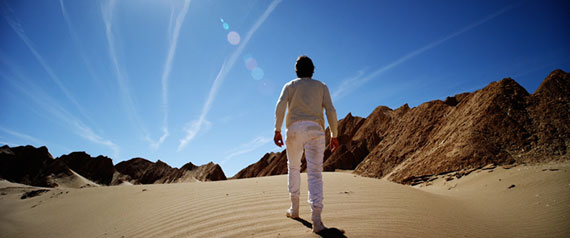Blue Desert (2013) Movie Review
Deserto Azul [Blue Desert], a Brazilian movie, follows Ele (Odilon Esteves) in a futuristic setting trying to find peace in a time where distractions and emptiness thrive. What starts as a promising search for enlightenment in a technology-driven world quickly loses focus, and we are left with a movie without a coherent and enjoyable conclusion. The problems within the movie include lack of character presence or interest, constant repetition of scenes, and overly extended filler scenes.
The main and supporting characters hardly stand out. Ele has some presence due to his internal dialogues, which explain his frustrations, but even he loses the capacity to engage us due to the slow pace of the movie. His opening monologue and beginning scenes quickly paint a portrait an unfulfilled life of merely existing, without personality or feeling. However, the character lacks any interesting qualities during his development. His best friend, who is never named, hardly adds to his discussion. He seems to understand Ele’s predicament, but he does not help the plot other than idle talking. The friend appears for talk during exercise twice and leaves never to appear again after a scene in a smoking room talking about Ele focusing on his subconscious revelations. Alma (Maria Luisa Mendonsa) serves as the future love interest for Ele, but she also contributes little to the plot. Orador e Pintor (Chico Díaz) gives small advice to Ele in his subconscious, but any interest in the character declines quickly after a short time. That these characters lack presence is not the fault of the actors alone; the central issue resides in the extended and unnecessary screen time on pointless scenes and constant repetition.
The movie spends too much time on redundant moments such as walking through the desert or repeated scenes before and during the party. Ele finds himself constantly in a desert for some form of a revelation, usually from a man spray painting the desert blue. However, a majority of these scenes have him running across the screen to find something for an extended time. The time it takes to get to that specific revelation reduces the impact it could have had. The anticipation dies and boredom sets in. Reducing the time spent on these superfluous scenes could have reduced the screen time and made a more active experience for the viewer. Where some scenes extend too long, others repeat with only minor changes.
Most of the problematic repeated scenes happen during internal dialogue or when Ele talks to his soon to be lover, Alma, and his future self. These scenes have annoying repeated backgrounds and lines that lack substance. The only scene that has a more ‘dramatic’ shift involves Ele and Alma switching dialogue toward the end of the movie. Ele does not understand the concept of silence until he is told to describe it himself. Other than that, the only locations that occurred involved a desert, pool, a party scene, and the main character’s home. The repeated use of sets and lines reinforce a dull feeling thereby providing little diversity and intrigue.
Blue Desert has no driving force to compensate for the lack of prominent characters and diverse settings. The lack of scene diversity, interesting characters, and plot progression unnecessarily stretched a philosophical message that could have been resolved in less time. All his struggles with wanting to stop thinking for a moment and finding purpose in a technology-driven climate take too long and have little impact. The concept of the movie has potential, but it drags due to improper execution.

